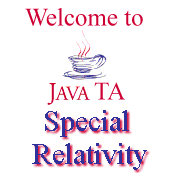Space-Time Lab - Tutor Page 12
 |
OK, here is another experiment that takes advantage of the speed of light always being c. In the object frame I have created a light clock. A light clock is made up of a photon bouncing back and forth between reflectors with a constant period. In the object frame this light clock has a period of 60 units - it takes 60 units of time for the photon to go from one reflector, to the other reflector and then back. However, when I give this clock a velocity v close to the speed of light and observe it, what happens? A) The clock's period is now longer - to the observer it takes longer for the pulse to get back to the starting reflector, which means the object's time is slowed. B) The clock's period is now longer - because of its movement this clock is no longer a functioning timepiece. C) The clock's period is now longer - to the observer the clock ticks off more units of time meaning that the object's time moves quicker. Choose a letter and Click Next. |
| Back Page 12 | A B C |
Questions or Comments? Send email to phys1@its.caltech.edu | |